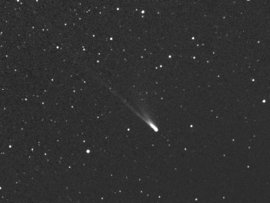Interstellar comet

An interstellar comet is a comet (or exocomet) located in interstellar space,[1] and not gravitationally bound to a star.[2] Besides known comets within the Solar System, or known extrasolar comets,[3][4][5] no interstellar comet, not gravitationally bound to a star, has been conclusively identified. Nonetheless, such comets are conjectured to exist: gravitational scattering by planets and passing stars has ejected many Oort cloud comets from the Solar System, and the likelihood of similar processes in extrasolar planetary systems suggests the existence of a large population of unbound cometary bodies.[1] At present, an interstellar comet can only be detected if it passes through the Solar System, and could be distinguished from an Oort cloud comet by its strongly hyperbolic trajectory (indicating that it is not gravitationally bound to the Sun).[2] Comets with weakly hyperbolic trajectories have been observed, but the trajectories of these comets are consistent with having been knocked loose from the Oort cloud and do not indicate an origin in interstellar space. The most eccentric known comet, C/1980 E1, only has an eccentricity of 1.057,[6] far less eccentric than an interstellar comet would be expected to be.
Current models of Oort cloud formation indicate that more comets are ejected into interstellar space than are retained in the Oort cloud, by a factor of 3–100.[2] Other simulations suggest 90–99% of comets are ejected.[7] There is no reason to believe comets formed in other star systems would not be similarly scattered.[1]

If interstellar comets exist, they must occasionally pass through the inner Solar System.[1] They would approach the Solar System with random velocities, mostly from the region of the constellation Hercules because the Solar System is moving in that direction.[8] The fact that no comet with a speed greater than the Sun's escape velocity[9] has yet been seen places upper limits to their density in interstellar space. A paper by Torbett indicates that the density is no more than 1013 (10 trillion) comets per cubic parsec.[10] Other analyses, of data from LINEAR, set the upper limit at 4.5×10−4/AU3, or 1012 (1 trillion) comets per cubic parsec.[2]
An interstellar comet could, on rare occasions, be captured into a heliocentric orbit while passing through the Solar System. Computer simulations show that Jupiter is the only planet massive enough to capture one, and that this can be expected to occur once every sixty million years.[10] Comets Machholz 1 and Hyakutake C/1996 B2 are possible examples of such comets. They have atypical chemical makeups for comets in the Solar System.[9][11]
See also
References
- 1 2 3 4 Valtonen, Mauri J.; Jia-Qing Zheng; Seppo Mikkola (March 1992). "Origin of oort cloud comets in the interstellar space". Celestial Mechanics and Dynamical Astronomy. Springer Netherlands. 54 (1-3): 37–48. Bibcode:1992CeMDA..54...37V. doi:10.1007/BF00049542. Retrieved 2008-12-30.
- 1 2 3 4 Francis, Paul J. (2005-12-20). "The Demographics of Long-Period Comets" (PDF). The Astrophysical Journal. 635 (2): 1348–1361. arXiv:astro-ph/0509074
 . Bibcode:2005ApJ...635.1348F. doi:10.1086/497684. Retrieved 2009-01-03.
. Bibcode:2005ApJ...635.1348F. doi:10.1086/497684. Retrieved 2009-01-03. - ↑ "'Exocomets' Common Across Milky Way Galaxy". Space.com. 7 January 2013. Retrieved 8 January 2013.
- ↑ Beust, H.; Lagrange-Henri, A.M.; Vidal-Madjar, A.; Ferlet, R. (1990). "The Beta Pictoris circumstellar disk. X - Numerical simulations of infalling evaporating bodies". Astronomy and Astrophysics (ISSN 0004-6361). 236: 202–216. Bibcode:1990A&A...236..202B.
- ↑ Sanders, Robert (7 January 2013). "Exocomets may be as common as exoplanets". University of California, Berkeley. Retrieved 8 January 2013.
- ↑ "JPL Small-Body Database Browser: C/1980 E1 (Bowell)" (1986-12-02 last obs). Retrieved 2010-01-08.
- ↑ Choi, Charles Q. (2007-12-24). "The Enduring Mysteries of Comets". Space.com. Retrieved 2008-12-30.
- ↑ Struve, Otto; Lynds, Beverly; Pillans, Helen (1959). Elementary Astronomy. New York: Oxford University Press. p. 150.
- 1 2 MacRobert, Alan (2008-12-02). "A Very Oddball Comet". Sky & Telescope. Retrieved 2010-03-26.
- 1 2 Torbett, M. V. (July 1986). "Capture of 20 km/s approach velocity interstellar comets by three-body interactions in the planetary system". Astronomical Journal. 92: 171–175. Bibcode:1986AJ.....92..171T. doi:10.1086/114148.
- ↑ Mumma, M.J.; Disanti, M.A.; dello Russo, N.; Fomenkova, M.; Magee-Sauer, K.; Kaminski, C.D.; D.X. Xie (1996). "Detection of Abundant Ethane and Methane, Along with Carbon Monoxide and Water, in Comet C/1996 B2 Hyakutake: Evidence for Interstellar Origin". Science. 272 (5266): 1310–1314. Bibcode:1996Sci...272.1310M. doi:10.1126/science.272.5266.1310. PMID 8650540.
External links
| Wikimedia Commons has media related to Comets. |
| Look up Interstellar comet in Wiktionary, the free dictionary. |
